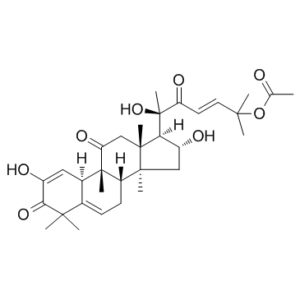Cucurbitacin E
This product is for research use only, not for human use. We do not sell to patients.

For small sizes, please check our retail website as below: www.invivochem.com
| Size | Price | Stock |
|---|---|---|
| 100mg | $920 | Check With Us |
| 250mg | $1600 | Check With Us |
| 500mg | $2400 | Check With Us |
Cat #: V4971 CAS #: 18444-66-1 Purity ≥ 98%
Description: Cucurbitacin E, a naturally occurring triterpene analog isolated from the climbing stem of Cucumic melo L with a potential therapeutic agent for metabolic diseases, significantly suppresses the activity of the cyclin B1/CDC2 complex.
Top Publications Citing Invivochem Products
Publications Citing InvivoChem Products
Product Promise

- Physicochemical and Storage Information
- Protocol
- Related Biological Data
- Stock Solution Preparation
- Quality Control Documentation
| Molecular Weight (MW) | 556.69 |
|---|---|
| Molecular Formula | C32H44O8 |
| CAS No. | 18444-66-1 |
| Storage | -20℃ for 3 years in powder formr |
| -80℃ for 2 years in solvent | |
| Synonyms | Cucurbitacin E; α-Elaterin; α-Elaterine |
| Protocol | In Vitro | To explore the antitumor activity of Cucurbitacin E (CuE) against colorectal cancer (CRC) cells, an in vitro study is initiated in which each of the CRC cell lines is exposed to increasing doses of Cucurbitacin E (0, 2.5, 5, and 7.5 μM) over a period of 24 h. The proliferation of the Cucurbitacin E-treated cancer cells is then measured using the MTT method. Cucurbitacin E is shown to induce morphological changes in the primary colon cancer cells. Microscopic observation showed that following exposure to Cucurbitacin E (5 μM) between 6 and 24 h, the primary colon cancer cells underwent a remarkable change in morphology. Cucurbitacin E inhibits tumor growth by arresting the cell cycle in the G2/M phase via GADD45γ gene expression and the blockage of cyclin B1/CDC2 complex in primary CRC cells. |
|---|---|---|
| In Vivo | A high fat diet mice model of metabolic syndrome (HFD-MetS) is developed to assess the role of Cucurbitacin E (CuE) on body weight and fat tissue biology. Significant decrease in body weights of HFD-MetS mice treated with Cucurbitacin E (0.5mg/kg) are found as compared to HFD-MetS mice treated with vehicle alone. Cucurbitacin E treatment reduces all fat pads weights in HFD-MetS mice. 55% reduction is observed in total fat in mice, after treatment with Cucurbitacin E in comparison to HFD-MetS mice. Abdominal obesity is strongly associated with metabolic syndrome. Central obesity is reduced to 50% after Cucurbitacin E treatment as compared to HFD MetS mice, elucidating the effectiveness of Cucurbitacin E in targeting MetS. |
These protocols are for reference only. InvivoChem does not
independently validate these methods.
| Solvent volume to be added | Mass (the weight of a compound) | |||
|---|---|---|---|---|
| Mother liquor concentration | 1mg | 5mg | 10mg | 20mg |
| 1mM | 1.7963 mL | 8.9817 mL | 17.9633 mL | 35.9266 mL |
| 5mM | 0.3593 mL | 1.7963 mL | 3.5927 mL | 7.1853 mL |
| 10mM | 0.1796 mL | 0.8982 mL | 1.7963 mL | 3.5927 mL |
| 20mM | 0.0898 mL | 0.4491 mL | 0.8982 mL | 1.7963 mL |
The molarity calculator equation
Mass(g) = Concentration(mol/L) × Volume(L) × Molecular Weight(g/mol)
Mass
=
Concentration
×
Volume
×
Molecular Weight*
The dilution calculator equation
Concentration(start)
×
Volume(start)
=
Concentration(final)
×
Volume(final)
This equation is commonly abbreviated as: C1 V1 = C2 V2
Concentration(start)
C1
×
Volume(start)
V1
=
Concentration(final)
C2
×
Volume(final)
V2
Step One: Enter information below
Dosage mg/kg
Average weight of animals g
Dosing volume per animal µL
Number of animals
Step Two: Enter the in vivo formulation
%DMSO
+
%
+
%Tween 80
+
%ddH2O
Calculation Results:
Working concentration:
mg/ml;
Method for preparing DMSO master liquid:
mg
drug pre-dissolved in
µL
DMSO(Master liquid concentration
mg/mL)
,Please contact us first if the concentration exceeds the DMSO solubility of the batch of drug.
Method for preparing in vivo formulation:
Take
µL
DMSO master liquid, next add
µL
PEG300, mix and clarify, next add
µL
Tween 80,mix and clarify, next add
µL
ddH2O,mix and clarify.
Note:
- (1) Please be sure that the solution is clear before the addition of next solvent. Dissolution methods like vortex, ultrasound or warming and heat may be used to aid dissolving.
- (2) Be sure to add the solvent(s) in order.




































